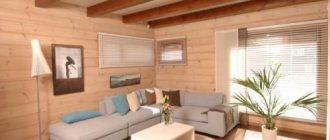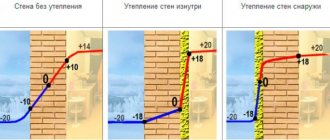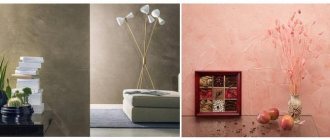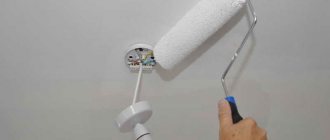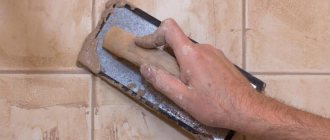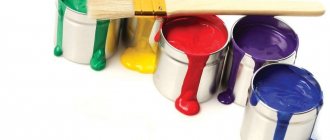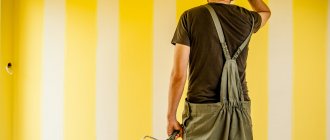Wood is an excellent finishing material: beautiful, durable, warm. However, all these wonderful qualities of wood products are demonstrated only if they are properly cared for.
Choosing an antiseptic
One of the important parts of care is protecting the wood from moisture and related factors.
Types of funds
Coverings for lining are divided into two main groups: protective and finishing (decorative). The first group includes compounds that have different working functions. Some are impregnations, others are covering materials. Both of them create a barrier against negative external factors.
Impregnations suitable for lining:
- covering soil;
- stain;
- wax;
- oil;
- specialized impregnation;
- antiseptics;
- drying oil;
- bleach;
- fire retardant
Several layers of stain with and without the addition of toners look different Source elka-palka.ru
Covering finishing materials act as a decorative layer, simultaneously serving as both protection and decoration. When there is no desire to cover up the wood pattern and its color, the coating composition is chosen from among the following translucent options:
- glossy or matte clear varnishes;
- tinted clear varnishes;
- translucent varnishes;
- wax;
- aqualak on acrylic;
- translucent enamel;
- decorative azure.
Brushed lining is coated with water-soluble transparent varnish Source 1povagonke.ru
For other cases, in which the natural color, texture and pattern of the board are unimportant, the lining inside the house is processed using covering materials. These include:
- acrylate, acrylic paints;
- oil paints;
- water-based paints.
Painting new lining with acrylic paint - the first layer of light green color Source sparta-stroy.ru
Wax belongs to the group of coating materials and impregnations. It all depends on the technology and the thickness of the applied layer. The degree of gloss of the coating depends on the duration and technique of polishing during waxing. In this case, wax can be called a coating material. The longer the procedure is carried out, the more the working wax surface approaches gloss. The less and less intensive grinding is done, the more the matte structure of the wax coating is preserved.
How is wood impregnated during interior work?
It has long been known that wood has a number of disadvantages:
- Absorbs and releases moisture, which can cause various physical parameters to change.
- The material is subject to rotting, which causes it to deteriorate and lose its original properties.
- Highly flammable.
It is for these reasons that wood impregnation for interior work is a must. Wood needs to be protected, not only indoors, but also from the street. Moreover, the materials used to apply the protective layer will be different; this issue must be taken seriously.
Any products made from wood should be treated with special antiseptics. This applies not only to wooden floors, walls, partitions, but also to furniture. Today you can buy various antiseptics, such as, for example, those made in. They meet all the requirements:
- High Quality.
- Repel dirt and water.
- They create a fire retardant layer, so the wood does not catch fire for a long time.
Modern materials for impregnating wooden structures can not only protect wood indoors, but also remove imperfections and natural defects.
Why use impregnation?
Some owners have doubts about the need to impregnate wood paneling inside a suburban building. If the boards are not covered, changes will be noticeable on them after some time. With poor ventilation, the lining will appear blue; as a result of intense sunlight, it may become dark gray.
The blueness is explained by the action of microorganisms, which can be gotten rid of with the help of active oxidizing agents, such as chlorine. The procedure is not very easy to perform and is accompanied by the release of an unpleasant odor.
The plaque, which has turned gray from the sun, can be removed by mechanical grinding of the lining, but the positive effect will not last long. It is more advisable to carry out the treatment immediately after finishing, so as not to have problems later.
In addition, the coating transforms the wood and makes the interior special. Lining coated with waterproof impregnation can last longer even in an irregularly heated, damp room.
Types of impregnations by purpose
In terms of functionality, there are impregnations:
- Antiseptic - prevent the development of microorganisms (fungi, mold, bacteria). It is antiseptics that protect wood from blue stains, rot and damage by insects.
- Water-repellent - do not allow moisture to penetrate deep into the material and, thereby, prevent its deformation. Most often they also have an antiseptic effect.
- Fire-resistant - for a long time prevent the ignition of wood under the influence of fire. The effect is achieved due to the presence of fire retardants in the composition.
- Frost-resistant - increases the resistance of wood to sub-zero temperatures.
- Decorative - emphasize the unique wood texture, and also give the wood the desired shade.
The best Decken impregnations combine antiseptic, water-repellent and decorative functions.
How to effectively protect a tree
How to treat the lining inside the house? This question is often asked by owners who have used wood in the interior decoration of their home.
Today, processing lining inside the house is not a problem. You just need to choose the right protective coating that will suit a particular room.
Some are more suitable for rooms with high humidity, others perfectly protect boards from ultraviolet rays, and some generally increase the strength of wood and prevent the risk of premature abrasion.
But also an important factor when processing is that the protection should look good on the boards . It should not distort the natural structure of the tree. On the contrary, its task is to emphasize the naturalness of the material used and blend harmoniously with the rest of the interior.
Most often, the following substances are used to protect wood:
Does wood need impregnation?
Like any organic material, wood is vulnerable to fungi, bacteria and mold, and is also defenseless against insects and rodents. Under the influence of atmospheric factors, the tree is deformed and prematurely destroyed. Therefore, the material needs special protection from negative influences.
Why do you need protective impregnation:
- Creates a layer on the surface of the wood that does not allow moisture to penetrate the fiber structure.
- Prevents swelling, deformation, cracking and destruction of solid wood.
- Prevents the creation of conditions favorable for the development of fungus, bacteria and mold.
- Repels insects and other pests.
- Provides an attractive appearance of the material.
The best impregnations emphasize the decorative advantages of wood and allow the wood to “breathe” - that is, allow air to pass through. Full natural air exchange is very important for the free removal of moisture and maintaining a healthy microclimate in the house.
A tree not treated with protection quickly loses its attractive appearance. It changes color under the influence of moisture and ultraviolet radiation, can change shape, traces of fungus and mold development appear on its surface, cracks and other damage form. In unfavorable conditions, wood begins to rot. This is why it is so important to use high-quality protective impregnations.
Lining protection. Features and feasibility
You should not apply a huge amount of protective agents to the finishing of the room. It is worth limiting yourself to 1-3 options that will be truly appropriate for a particular room. The covering of wooden lining inside a residential building and inside a dacha, where the owners appear a couple of times a year, should be different.
For high-quality setting of protective equipment, before carrying out work, both new and used lining should be cleaned of debris, dust, and covered with a layer of primer. The liquid primer is quickly absorbed into medium-density wood and creates a good base for applying chemicals.
Antiseptics
Must be applied to any type of wooden lining. This is the main layer of protection for medium-density wood (linden, alder, etc.). Antiseptics prevent wood from rotting in places where moisture accumulates. A water-based liquid antiseptic is applied with a brush or roller to the lining sheets that have not yet been installed, after which they are absorbed by the wood for 1-2 days.
Particular attention should be paid to the locks on the lining and the cut points. In the first case, the antiseptic must be “poured” into the cracks so that there are no uncovered areas left. In the second, simply go through the liquid solution again 1-3 hours before installing the sheets.
Often, anti-rotting agents are applied to the lining during production. Long-term storage in poorly ventilated warehouses or transportation in unfavorable conditions affects the quality of the lining, contributes to the occurrence of rot, fungus, etc. It is worth carefully studying the data sheet of materials to determine the feasibility of purchasing and applying various products.
UV protection
More expensive and specific type of protection. Suitable for rooms with windows on the sunny side of the house. It is a medium-thick liquid, applied last (after antiseptics and other products, including clear varnish).
UV protection prevents lining from “fading”—loss or change in color due to prolonged exposure to sunlight. A topical product for covering the finishing of a cottage or country house with large windows, provided that the lining is not painted with oil paint. Clear varnishes and stains can be combined with this type of coating, but if you have the funds, you should think about buying a combined product (varnish + UV protection in one mixture).
Protection from physical damage
Mixtures to increase the density of the material. The main reason to purchase them is to improve the quality of softwood lining. Small scratches, cracks, and dents darken over time and can significantly spoil the appearance of the finish. This type of protection is relevant for rooms with eurolining, which are often visited by people (hall, corridor).
Ignition protection
How to cover lining in a residential building to prevent fires? A special composition that prevents the tree from catching fire at the slightest spark. It is used everywhere, especially in rooms with a complex wiring system, an installed fireplace, or in rooms where people often smoke. Often this layer of protection is also applied at the factory. The product is not too expensive, but for a large room the price may be an issue.
The best wood impregnation for interior work
When taking care of protecting your tree, it is important to remember your own safety. Therefore, impregnations for interior work are selected taking into account environmental friendliness. Experts paid attention to several compounds.
Pinotex Interior
Rating: 4.9
Pinotex Interior impregnation forms an effective protective film on wood. The paint and varnish products of the Estonian manufacturer have proven themselves well in the harsh Russian climate. The composition is water-based and does not have a pungent odor. Experts note the ease of application of the antiseptic; drips do not form during operation. Quick drying of the treated surface is combined with uniform absorption, which makes the structure of the wood expressive and beautiful. On the matte layer formed, fingerprints and small wood defects are not visible.
Users are satisfied with the appearance of the matte finish and the reliable protection of the wood from moisture and dirt. One of the disadvantages is the appearance of counterfeits on the domestic market.
Advantages
- safety and environmental friendliness;
- wide range of shades;
- quick drying;
- no smell.
Flaws
- There are counterfeit products.
Manufacturers of wood treatment products
Not all products on the market are of the highest quality. But there are a number of manufacturers who have been receiving positive recommendations from consumers for several years. Among the many offers on the market, the following brands of varnishes and wood paints stand out:
- Finncolor (Russia). Acrylate gloss and semi-gloss varnishes are easy to dilute with water while working. Pigments can be added to them. They are great for covering ceilings, walls, niches, door openings, and windows. Not for use on floors or furniture. The main function of protection is to stop the natural destruction of wood, to create a barrier when dirt, moisture, and harmful microorganisms (mold, mildew) get on the surface. Average costs - 1 liter per area of 5-12 square meters. m. Blend – 9 l. Approximate price – 2000 rubles.
- Composite (Russia). A quick-drying varnish without color or pungent odor is suitable for walls, ceilings, wood materials such as lining, non-laminated chipboard, fibreboard, OSB and MDF. One liter of product will cover an area of 8-12 square meters. m. Price for 1-3 liters – from 300 rubles, 10 liters – 2200 rubles.
- Commander (Finland). Varnishes with a ready-made coating of varying degrees of gloss. They are environmentally friendly, do not have a sharp specific odor, and can be used in children's rooms. The layer of varnish on the lining easily repels dirt and water and does not absorb fats. Consumption – 1 liter per 8-12 square meters. m. Small containers of 0.9 liters priced from 350 rubles. Medium (2.7 l) and large (9 l), respectively, cost more.
- Eurotex (Russia). The “Sauna” modifier is an ideal solution for rooms with high humidity. The product is used for bathrooms lined with lining, kitchens, baths, saunas. The composition contains wax, densely distributed over the surface, capable of withstanding high temperatures and humidity. The average price for 2.5 liters is 500 rubles.
- Colorex (Sweden). “Panellac” is an excellent primer for processing lining from new boards and an ideal finishing coat for already finished euro lining. Can be used on walls, ceilings and even furniture. Well protects wood from discoloration and aging, scratches due to mechanical stress. It has a hardening effect on wood. For 8-14 sq. m. only 1 liter is spent. Cost for 0.9 l - 750 rubles, 2.7 l - 1800 rubles, 9 l - 5000 rubles. “Supisauna” is an effective matte varnish for rooms with high humidity. Protects the lining from rot and darkening. Prices - 600-4000 rubles, depending on the volume of displacement.
- Belinka (Slovenia). Due to the fact that there are no biocides in the composition, the paint can be used inside the house. Thin-layer and colorless coatings are suitable for wood. They only give a matte shine. Very economical consumption - for 3 layers of 10-12 sq. m. area is enough for 1 liter. The approximate cost for 1-2.5 liters is from 600 rubles.
- Pinotex (Estonia). The “Interior” collection was released specifically for treating surfaces inside the house. The impregnation is a transparent, odorless liquid that is easily distributed over the surface of the lining. Composition: alkyd resin, light-resistant pigments, water. Blend volumes – 1.3-10 l. Costs on average are 1 liter per 8-16 square meters. m. Price – from 650 rub.
Translucent varnish “Commander” Source ales-spb.ru
Belinka brightening varnish is applied in one layer over untreated lining Source bsm21.ru
Varnishes and paints are applied with a brush and a roller made of a fur coat. On large areas, the lining is processed using special pneumatic devices - spray guns. They allow you to distribute the product evenly by spraying.
Consumption! The amount of material spent depends on the quality of the board, the number of layers, as well as the primary processing. The very first layer will be absorbed fastest and most deeply. If the structure of the wood is too “porous”, then the varnish or paint on the first layer goes deep into the microspace between the fibers.
The best wood impregnation for outdoor use
Wooden structures located outdoors are negatively affected by rain, sun, and frost. Therefore, impregnation requires maximum resistance to weathering. Experts liked the following drugs.
Tikkurila Eko Wood
Rating: 4.9
It is possible to preserve the natural beauty of wood using the glaze composition Tikkurila Eko Wood. Experts gave impregnation the first line of the rating for reliable protection against atmospheric influences. It neutralizes the effect of water, ultraviolet radiation and microorganisms on wood. The antiseptic has proven itself well when treating the external walls of houses, doors, windows, fences, terraces, etc. The manufacturer’s catalog contains 40 colors, which allows you to choose the most suitable tint.
The product is produced in St. Petersburg, which makes it affordable for many Russian consumers. Users like the good penetrating ability of the antiseptic and long-lasting protection of external surfaces.
Advantages
- preserves the natural beauty of the tree;
- protects well from biological damage;
- prevents wood from fading in the sun;
- acceptable price.
Flaws
- not detected.
Luxens
Rating: 4.8
The well-known company Leroy Merlin organized the production of Luxens impregnation in Russia. Both colorless and colored antiseptics come off the production line of the enterprise. The composition won second place in the ranking for its economical consumption, weather resistance, and ease of application. The durability of the protective coating is 3-4 years, while maintaining the natural appearance of wooden bases. Thanks to the alkyd base, the impregnation has a moderate odor, which does not cause problems when performing outdoor work. By the way, immediately after the layer dries, the smell completely disappears.
Users note the low consumption of impregnation; even one layer is enough to protect wooden structures. Not everyone is happy with the smell of the composition; it is not very convenient to apply the product with a brush.
Advantages
- emphasizes the beauty of the tree;
- long-term protection against biological damage;
- affordable price;
- economical consumption.
Flaws
- unpleasant smell.
Pinotex Ultra
Rating: 4.8
Weather resistance and decorative properties were the main factors for Pinotex Ultra impregnation to reach third place in the rating. The manufacturer offers both colorless and colored formulations. The coating not only protects the wood from water and UV rays, but also prevents combustion. The formulation contains a special filter that prevents sunlight from penetrating into the wood structure. Thanks to it, the natural texture of the wood is preserved for many years. To improve absorption into the base, the manufacturer has developed a special AWB technology.
Users liked the ease of application, lack of splashing and drips, moisture resistance and dirt-repellent abilities. The disadvantages include the high price and long drying time.
Advantages
- good protection against burnout;
- water- and dirt-repellent ability;
- beautiful view;
- high quality.
Flaws
- high price;
- takes a long time to dry.
EXTREME CLIMATE
Rating: 4.7
Any type of wood will be protected from external influences by EXTREME CLIMATE impregnation. The composition is water-based and is intended for indoor and outdoor use. Antiseptic-treated wood is not afraid of rain, snow, or sunlight. Deep penetration into the structure prevents the appearance and reproduction of insects. Microfilm is distinguished by its ability to allow air to pass through, so the natural material can “breathe”.
In reviews, users speak flatteringly about the fast drying of the impregnation, lack of odor and good coverage. Among the disadvantages, there is a high price, as well as a shortage of the product in the retail chain. Therefore, impregnation stops one step away from the top three in the rating.
Advantages
- versatility of use;
- reliable protection from atmospheric influences;
- no unpleasant odor;
- breathable film structure.
Flaws
- high price;
- shortage in the trading network.
Dufa Wood Protect
Rating: 4.7
Dufa Wood Protect impregnation has a wide range of applications. With this composition, durable protection of external wooden surfaces is provided. It is recommended to treat walls and facades of houses, gazebos and fences. The matte finish completely preserves the attractiveness of the texture. Thanks to the acrylic-alkyd base, a reliable barrier is formed for weather influences. Impregnation can be applied to wooden structures by any means; the drying time of the layer at 20°C is only 1 hour. The composition occupies fifth position in the ranking.
Domestic consumers liked the smooth surface after application, ease of application, and lack of odor. The high price prevents the use of antiseptics for large volumes of work.
Advantages
- no smell;
- durable weather protection;
- washes off easily;
- smooth coating.
Flaws
- high price;
- Several layers are required.
Nortex-Disinfector
Rating: 4.6
Antiseptic Nortex-Disinfector is used to protect not only wooden bases, but brick and concrete structures from mold and mildew. Experts praised the impregnation’s ability to treat “diseased” material. The action of the drug is based on deep penetration into the structure and an antiseptic effect on fungus and mold. The manufacturer recommends using the product in extreme conditions (increased dampness, contact with soil). After drying, the layer does not lighten or tint the wood, preserving its natural beauty.
The composition was included in our rating due to its price-quality ratio. Users noticed several disadvantages, which included a long drying time (10-15 days), inconvenient packaging and a modest range.
Advantages
- treats diseases;
- penetrates deeply into the structure;
- preserves the beauty of natural material;
- acceptable price.
Flaws
- takes a long time to dry;
- inconvenient packaging;
- modest assortment.
Types of compositions
How to cover the lining inside a house is an easily resolved question, because there are many products on sale for different climatic zones and types of buildings.
Composite impregnations are designed to perform several functions, the main ones of which are the following:
- decreased flammability,
- protection against microbes,
- improvement of appearance,
- increasing mechanical strength.
There are products designed primarily to protect the lining, and compositions created for a decorative effect. Many drugs perform multiple functions equally successfully.
Method of application inside
How to properly use antiseptic agents to protect wood?
If a consumer wants to achieve high-quality protection using wood impregnation for interior work, then they must carefully read the recommendations for use. Otherwise there will be no benefit from the processing. How to properly treat with antiseptics and protective agents:
- You need to start work only at a certain temperature, which should not be below five degrees Celsius.
- First you need to remove all dirt, including old paint. Wood that has fungus or mold is pre-disinfected using a bleach.
- The solution is poured into a sealable container to make it easier to shake.
- For work, you can use a roller or brush. The composition is applied several times. If the surface has been affected by fungus, mold, rot or insects, then pay special attention to its treatment. In this case, at least two hundred grams of antiseptic will be required per square meter.
- The treated surface is left to dry overnight. A good effect will occur if the air is heated to 20 degrees and the air humidity does not exceed 60 percent. In this case, the impregnation will adhere to the surface and create a layer resistant to aggression.
If the treatment was carried out correctly, then wooden structures will be safe for about three decades.
Despite the fact that these protective equipment are not toxic substances, work must still be performed while wearing personal protective equipment. With glasses, gloves, and a respirator, you will feel more confident.
Main types of antiseptics
The main requirement for any antiseptic impregnation is protection, and regardless of the place of use, it must be waterproof.
Today it is not a problem to choose the right composition, because manufacturers produce narrowly targeted lines, for example, special ones for baths or saunas , based on wax, which will prevent the lining from darkening over time, forming a stable film on the surface of the material.
In addition, using an antiseptic you can give the surface a glossy shine or change the color. And if you are going to paint the lining, then experts recommend using a translucent antiseptic.
It will serve as additional protection and will muffle the bright wooden ornament, so the paint can be applied in one layer.
Properties of antiseptics
The compositions are distinguished by the method of application and the additional functions that they perform.
- Impregnation is a preparation with which the lamellas are pre-treated before assembly. It penetrates deeply into the top layer of wood and prevents the development of bacteria. The top of the product is coated with varnish, paint or wax.
- Coating – it contains toxic substances. The coating is applied last and is more often used for external work. This group includes compounds that provide protection against insects.
Wood is a flammable material, and they try to partially preserve this problem with the help of special antiseptics - fire retardants.
- Blocking - the composition foams when the wood catches fire and blocks the spread of fire.
- Fire prevention – the preparation contains components that prevent the wood from catching fire.
How to choose an antiseptic
The choice is determined by the purpose of the finish and the operating conditions of the room or building. Whether a composition is considered environmentally friendly or not, in this case, depends on its toxicity to humans.
Required tools and materials
In addition to the impregnating composition itself, you need to prepare tools for application. This could be a spray gun or a set of brushes of different sizes. The product packaging provides detailed application instructions and recommended tools.
Also useful for work:
- construction tape;
- absorbent wipes;
- container for coloring product;
- sandpaper No. 240.
To coat the joint areas, it is better to prepare a separate small brush. To prevent lint from sticking to the surface, instruments should be periodically rinsed in a soapy solution. It is worth doing this before you start applying the product.
Reasons why lining should be processed
The pleasant color of untreated lining will not please the eye for long. The wood will begin to deteriorate during use inside the house. Before you look for how to process the lining, you need to understand the reasons why it loses its beautiful appearance. Wood can be affected by dampness, attack by pests and, finally, even the simplest grease stains and abrasions.
Several main reasons why lining needs treatment with protective agents:
- Waterproofing. Boards become more resistant to water if there is high humidity in the room.
- Antiseptic. Fungal spores and mold microorganisms will not be able to get into the very depths of microcracks in the fibrous structure of the tree.
- Barrier against pests. No bark beetle (wood borer) or any other insect pest can destroy the wooden covering.
- Color preservation. The treated lining does not darken over time and retains its natural color throughout its entire service life.
- Health safety. If the lining is made of coniferous wood, then the release of their resins from the board stops after it is treated with protection. This nuance is important for rooms where people sleep or stay most often.
- Fire safety. The high flammability of wood can be reduced if it is treated with fire retardants in several layers.
Impregnation ensures the brightness and preservation of the color of the lining Source winterhouse.ru
Treating the wood surface with a fire retardant to protect it from fire Source sigma01.ru
The tree will retain its integrity longer in conditions of high humidity because the protective layer of impregnation or covering material will prevent it from swelling and rotting. When attacked by small insects, a layer of protection will prevent the wood from turning into dust. If a protective layer of impregnation is periodically applied to the surface of unpainted lining, then it will become stained and retain all its design properties - color, texture of smooth curves, pattern of wood stains.
Which wood impregnation is better: main types by composition
Various components are used to produce impregnations; they affect the resulting effect. Therefore, you should understand the different types, then choosing the appropriate option will be easier.
Various components are used to produce impregnations; they affect the resulting effect.
Water-soluble and oil-based
Water-based solutions are safe for humans, without a strong odor, dry quickly, and can be applied to a damp surface. Disadvantages: penetration depth is low, cannot be used on objects that have constant contact with water, they protect only superficially.
Oil paints are characterized by a high penetration depth, create a reliable layer against moisture, are commonly used for painting objects located outside, and create a shiny coating. They do not have fire protection properties and are short-lived.
Oil-based products have a high penetration depth and create a reliable layer against moisture.
Solvent based
Designed for covering facades, they are distinguished by elasticity and moisture-repellent properties. Good adhesion to the surface, therefore it is used before using paints.
Designed for covering facades, they are distinguished by elasticity and moisture-repellent properties.
Alkyd and acrylic
Alkyd solutions contain the same resins, wax, and oil. Protects against natural precipitation and impacts, preserving the natural grain of the wood. The downside is the difficulty of application; you need to work with a roller or brush, which delays the process.
Acrylic products are suitable for interior and exterior decoration. They are environmentally friendly, moisture-proof, strengthen the wood base, prevent rotting, and serve as protection against biological influences. They do not tolerate low temperatures well.
Acrylic products are suitable for interior and exterior decoration.
Salt and bitumen based
The salt form is sold ready-made or as a powder that needs to be diluted. Protects against biological influences and pests, creates a fire-resistant coating. Their use with a brush reduces the resulting properties. It is better to soak objects in them or use them in a vacuum chamber. For this reason, they are rarely used in everyday life, more often for industrial purposes.
Bitumen impregnation is thick and black in color. Usually it is prepared independently and is used to cover objects located outside the building. The layer turns out dense.
Bitumen impregnation is thick and black in color.
Features of applying impregnation
There are several types of lining; they differ in the number and shape of joints on the resulting surface. Depending on this, a different amount of effort will be required to prepare it.
In any case, before covering the lining with any means, you need to carefully examine all the boards. If there are dark spots, local lightening is carried out with bleach. Then the entire surface can be lightly washed with a diluted soda solution and wait until the water has completely evaporated. Only after this can the wood be treated with primer and the base compound or immediately with impregnation.
The cracks are covered with wood putty, everything is thoroughly cleaned with sandpaper.
To more effectively secure the decorative layer, the wood is primed. Very carefully you need to distribute the primer mass in the seams. To apply primer over the main part of the area, you can use a spray gun; at the joints it is better to prime with a brush.
Each product has its own application characteristics, which are necessarily described in the manufacturer’s recommendations. The accompanying documents must be carefully studied and the compositions prepared in accordance with the instructions. All products are applied in several stages; each subsequent stage can be performed only after the surface has dried, and the final layer must be the thinnest. Following these rules will help you get a reliable and beautiful coating.
The best fire retardant impregnations for wood
If the wood trim is located close to an open fire source, it must be treated with fire retardant impregnation. It makes wood a material that is difficult to combust, expanding its scope of application. Here are the best fire resistant formulations.
NEOMID 450
Rating: 4.9
A highly effective means for fire protection of wooden structures is NEOMID 450 impregnation. The composition can be used both inside and outside buildings. When the drug interacts with wood, a poorly flammable and difficult to burn material is formed. At the same time, the wooden surface is protected from rotting and mold. The domestic manufacturer promises up to 7 years of fire protection and 10 years of protection against biological damage. The product is offered to the consumer in colorless and tinted versions. Experts gave the composition first place in our ranking.
Users like the simultaneous protection of wood from biodamage and fire and the ease of use. The disadvantages include the long drying time (12-14 days) before applying paints and varnishes.
Advantages
- comprehensive tree protection;
- versatility of use;
- long service life of the coating;
- different application methods.
Flaws
- takes a long time to dry.
Senezh Ognebio Prof
Rating: 4.8
Comprehensive protection for wood can be created using Senezh Ognebio Prof. impregnation. After treatment, the base becomes difficult to combust, it is not subject to rotting, biodestruction, or the infestation of bugs. Wood becomes resistant to moisture and temperature changes. It is not recommended for treated elements to come into contact with the ground. Users should be aware that after drying the surface changes color, although the natural structure of the wood is preserved. The drug can also be used for biological damage to wood.
Having weighed all the pros and cons of the composition, experts gave it second place in the ranking. Users note the absence of odor, fire safety and ease of use. Among the disadvantages, the high consumption of antiseptic is often mentioned.
Advantages
- comprehensive tree protection;
- treats substrates contaminated with microorganisms;
- affordable price.
Flaws
- contact with the soil is not allowed;
- high consumption.
